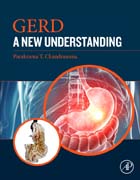
GERD: A New Understanding of Pathology, Pathophysiology, and Treatment
Chandrasoma, Parakrama T.
GERD: A New Understanding of Pathology, Pathophysiology, and Treatment transforms the assessment of GERD from its present state which is largely dependent on clinical definition and management to a more objective scientific basis dependent on pathologic assessment of biopsies, transforming the way GERD is defined. It provides an examination of the way the esophagus develops, the genetic signals that determine its epithelial composition through fetal life to full development, and the way exposure of the esophagus to gastric juice causes damage at a cellular level. Identification of cellular changes provides new pathologic criteria for diagnosis of GERD and delivers an accurate method of assessment of severity of damage to the lower esophageal sphincter using a new biopsy protocol. By providing new techniques of diagnosis of sphincter damage, new methods of identifying patients who will remain controlled with medical therapy emerge, permitting early intervention. Provides a new method of assessment for GERD that has never previously been presented, creating a new pathway to controlDescribes GERD from the basis of pathologic changes that can be defined by standard biopsy protocolsSequential chapters outline the way GERD progresses from the perspective of the amount of damage to the lower esophageal sphincter INDICE: 1. Introduction 2. Fetal development of the esophagus 3. Histologic definition of epithelial types in the esophagus and proximal stomach 4. The Normal Fully Developed Esophagus 5. Mechanism of Early Esophageal Damage in GERD 6. The Dilated Distal Esophagus 7. Histologic Assessment of Lower Esophageal Sphincter Damage 8. Evolution of cardiac epithelium 9. Intra-sphincteric Reflux Disease 10. Trans-sphincteric reflux disease 11. Asymptomatic GERD 12. Non-erosive Reflux Disease 13. Erosive Esophagitis 14. Present Management of GERD 15. Columnar Lined Esophagus (CLE) 16. Barrett Esophagus 17. Progression of Barrett esophagus to adenocarcinoma 18. Present methods of prevention of Esophageal adenocarcinoma 19: A new rationale for preventing esophageal adenocarcinoma 20. Linearity of Progression of lower esophageal sphincter damage 21. Interventions in patients predicted to progress to severe sphincter damage 22. A new management of GERD 23. The Goal of the Book
- ISBN: 978-0-12-809855-4
- Editorial: Academic Press
- Encuadernacion: Cartoné
- Páginas: 640
- Fecha Publicación: 01/10/2017
- Nº Volúmenes: 1
- Idioma: Inglés
